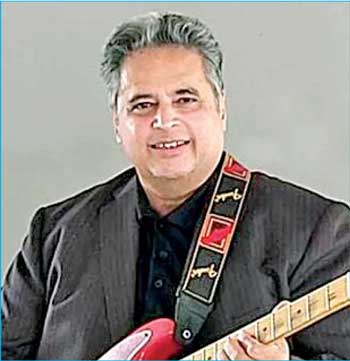Sunday Dec 07, 2025
Sunday Dec 07, 2025
Saturday, 4 October 2025 00:00 - - {{hitsCtrl.values.hits}}
 |
| Roger Menezes |
Roger Menezes’ name will resonate with anyone who’s grown up listening to the soundtrack of Sri Lanka’s golden era of music. With a career spanning over five decades, he’s shared the stage with legendary bands like The Jetliners, The Savages, Thunderbirds, and Fireflies, and later led his own ensemble, Roger and the Webs, before making Sydney, Australia, his home in 1973.
Known for his signature ‘hits and memories’ style, a blend of jazz, pop, and classic rock, Roger still draws crowds whenever he returns to Sri Lanka, performing at major venues and connecting with devoted fans.
In this exclusive interview, he reflects on his musical journey, the evolution of Sri Lanka’s music scene, and his thoughts on the role of AI in shaping the future of music.
By Michelle Therese Alles
Q: Roger, take us back to the very beginning: what inspired you to pursue music, and when did you realise it could become a career?
A: Being a Menezes, music was always in my DNA. I started playing drums at the age of 10, but what really inspired me was listening to the collection of jazz vinyls owned by my father, Mickey Menezes. From there, I never looked back; I just kept playing and loving music with a passion.
Q: Who were your earliest musical influences, and how did they shape your style and lead to the most defining moment in your musical journey?
A: My earliest musical influences were the jazz greats such as Dave Brubeck, Count Basie, Oscar Peterson, Glenn Miller, Stan Getz, Barney Kessel, and Gene Krupa.
Later on, artists like George Benson, Carlos Santana, and Tommy Emmanuel helped shape my approach to guitar, giving my music a slightly jazzy feel. The most defining moment in my musical journey came when I joined my first band, The Savages, as a drummer, taking over the spot of ‘Ringo Starr’ (each member adopting a different Beatle persona) in what was considered Sri Lanka’s answer to The Beatles back in the 1960s. From there, it was smooth sailing all the way.
Q: How do you stay true to your style while also exploring new sounds or trends?
A: For me, staying true to my style is all about humility. Ego has no place in music. When I receive compliments, I usually say, “I’m still learning,” because every day offers something new to discover. A solo I play today might sound completely different tomorrow, depending on how I feel at that moment, and that’s the beauty of music, it evolves with you. I’m not a heavy rock guitarist; I lean more towards a ‘hits and memories’ style, but I always try to add my own twist. Exploring new sounds and trends is important, but I believe it should always come from the heart. That way, you grow while still keeping your own voice.
Q: What challenges did you face in your early days as a musician, and how did you overcome them?
A: Well, there were so many! We didn’t have access to branded guitars, selective guitar strings, quality amplification, or even our own transport. Recording facilities were limited as well. Most of the time, we rehearsed at my home, and I think the neighbours actually enjoyed it! However, coordinating five or six band members on the same day was always tricky, as everyone had their own commitments. But our shared passion for music kept us going, and we found ways to make it work.
Q: Are there any collaborations that had a significant impact on your growth as an artist?
A: I’ve had the pleasure of performing with George Golla, one of Australia’s leading jazz guitarists. Next was a personal meeting with Hank B. Marvin of The Shadows, and he showed me his effects setup and even let me play his guitar, which was an amazing experience.
Hank has two Stratocaster guitars, one strung with light gauge strings, which he uses for pieces like Sleepwalk and Cavatina (The Deer Hunter theme), and another with heavier gauge strings for Shadows’ classics such as Shadoogie, Dance On, and Foot Tapper.
I also had a memorable chat with George Benson, who shared some valuable techniques and insights with me.
Q: How has the music scene in Sri Lanka evolved since you began?
A: The music scene in Sri Lanka has grown a lot from back then, and has overall become more vibrant and dynamic.
Q: What role does live performance play in your musical expression, and how do you connect with your audiences?
A: Professionalism and discipline are crucial, and it’s important to play for the audience, not just for oneself. Every performance should be done with love. You also need to read your audience, especially their age group, and mix your songs accordingly to make them pleasing to the ears. Never underestimate your listeners, even if there’s just one person paying attention. Have a playlist ready, but be flexible and adjust it on the go based on the crowd. You can’t please everyone, but you can aim to please as many as possible.
Q: With AI tools becoming increasingly popular in music creation and production, how do you feel about new musicians using AI, and what impact do you think it might have on the future of the industry?
A: Well, we’ve got to move with the times! The use of AI in music creation brings both exciting opportunities and new challenges for the industry. It’s especially popular among younger musicians and is gaining widespread acceptance. However, it allows anyone with a laptop to produce music without prior training or any formal musical education. Ultimately, the future of music will be shaped by how artists embrace these tools. As AI continues to grow, it will play an increasingly important role in the creative side of the industry.